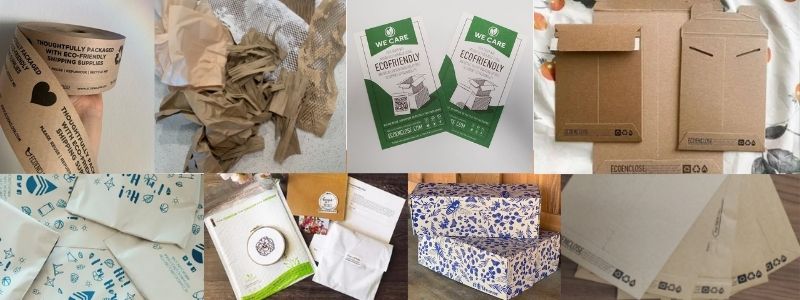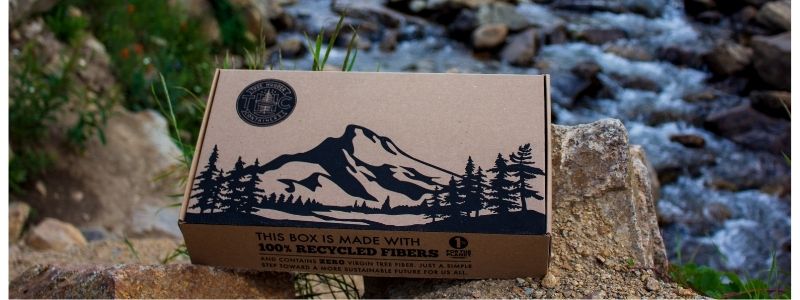What to Look for in Eco-Friendly Packaging & Supplies
Posted on Jul 16th 2021
What to Look for in Eco-Friendly Packaging & Supplies
Sustainable packaging can no longer be an afterthought. Your customers are actively seeking brands that prioritize eco-friendly packaging. Nearly six in 10 consumers are willing to change their shopping habits to reduce environmental impact and nearly eight in 10 respondents indicate sustainability is important for them.
But, what does eco-friendly packaging even mean? How can your business balance cost, functionality and sustainability? You’ve come to the exact right place! Our website is chock full of resources to help you navigate the tricky world of sustainable packaging, so you can develop a packaging strategy that matches your brand, your functional needs, your budget and your values.

Factors to Consider When Developing Your Sustainable Packaging Strategy
Form, function and durability
The number one thing is to ensure your packaging will protect your products in transit. This means:
- Choosing properly between a shipping box and a mailer
- If you choose to go with a mailer, choosing the right size, style and strength for your goods.
- If you choose a box, choosing the right box style, fluting and dimensions (which you can do with our Definitive Guide to Shipping Boxes)
- When necessary, selecting the right void fill to protect your goods and fill in any dunnage. Check out Definitive Guide to Void Fill for more guidance.
As you navigate and decide on these questions, you will likely land on one of several general strategies, including:
- Custom shipping box, in a presentation style and a B or E flute
- Custom shipping box, in a standard (RSC or FPF) style in a C flute
- Cushioned mailer, either a poly bubble mailer, paper padded mailer, or a paper / poly combination
- Rigid mailer, typically a style of a paper mailer
- Thin or flexible mailer for apparel, either a poly mailer or a paper based mailer
- Yes or no decision on whether or not you need void fill in your packaging strategy
This is a great start! Once you’ve determined the above, the next step is to identify how to make the packaging strategy you’ve developed to ensure safe transit of your goods also reflects your sustainability values. To make your eco-friendly packaging as thoughtful as possible, you’ll want to consider the following.
Need more guidance here? Check out our Definitive Guide to Ecommerce Packaging.
The Best Inputs For Sustainable Packaging
Recycled Content Rules: In almost all cases, we recommend maximizing your recycled content as step one in your packaging strategy. In fact, we believe that the most important question to ask of your sustainable packaging is “How Much Post Consumer Waste is Included?”
What about FSC® certified Packaging: If you’re considering paper-based packaging, we believe that post consumer waste is superior to any virgin material, even if that virgin material is FSC® certified. Recycled paper has a carbon footprint that is up to 70% lower than virgin counterparts. And if you can avoid growing raw virgin materials, this is always preferred (even if those raw materials are certified to be more sustainable). Finally, we believe that ecommerce packaging is a well suited use case for recycled content, and a collective commitment to maximizing recycled content in the ecommerce packaging space will help to drive, sustain and create innovation across the recycling supply chain.
What about bioplastic packaging: Bioplastic packaging comes up frequently, as companies debate between bio-based or recycled content. Unfortunately, today’s commercially viable bioplastic technologies are based on corn, sugarcane, and other highly intensive crops that are heavily fossil fuel dependent (thereby negating the concept of them being “renewable”), highly polluting to our waterways and lands, and lead to the release of carbon sequestered in our soil. Given this, we strongly recommend that companies stick with recycled plastic over today’s “bio” plastic options. We are constantly exploring new bio-based inputs into plastic and hope that over time, we can help develop and bring to market an option where the inputs are net neutral and potentially even net positive to the planet. Read more: Why We Do Not Currently Sell Compostable Poly Mailers.
End of Life Options To Prioritize
Reuse and then recyclability should be your highest priority: We are building towards a more circular economy. This means that once a raw material is created, we want to see it being reused and then (when it can’t be reused anymore) put back into a new functional item that would otherwise need virgin inputs.
Should I use reusable packaging: Unfortunately, for most businesses right now - no. But, if your business has a very high rate of returns and returning product is core to your business model (like a StitchFix), then perhaps yes.
In almost all cases, we have found that reusable packaging uses more overall material, therefore creates more material waste, and creates a significantly higher carbon footprint than packaging designed for 1-2 uses. This is largely because (1) in order to make a reusable package, it needs to be durable and (2) customers don’t always send these mailers back and the rate of return is a major driver of impact. Fashion For Good has found that a reusable mailer would need to be returned almost 100% of the time in order for it to be better for the planet than a recycled single use poly mailer.
What about compostable packaging: Avoid designing for compostability! Unless packaging is soiled with food waste, it is better for the planet for you to recycle the packaging than compost it. In fact, the only reason a small handful of composters do accept certified compostable packaging (the vast majority do not), is because they see it as a vehicle to carry food waste into compost instead of landfill. Design for recyclability over compostability.
Carbon Footprint of Packaging
A package’s carbon footprint is based on its raw materials, how much recycled content is used, and how it is shipped and stored. Many companies, like Walmart and McDonalds, focus on minimizing carbon footprint above all else. That said, other companies focus on different attributes - like going plastic-free or zero waste. Whether or not you make carbon footprint the top driver of your sustainable packaging strategy or focus on other features instead, we always recommend considering carbon footprint in your decision (as climate change, an issue driven by carbon emissions, is our planet’s most pressing ecological issue).
While expensive tools exist to conduct detailed LCA analyses, there are a few rules of thumb to go by when reducing carbon footprint:
- The higher the recycled content, the lower the carbon footprint
- The less material, the lower the carbon footprint
- The smaller the box / mailer, the lower the carbon footprint (because you are shipping less air)
- Plastic typically has a lower carbon footprint than paper
- The more localized the manufacturing of your packaging is, the lower the carbon footprint (because there is less shipping involved).
If you’re looking for tools to analyze the carbon footprint of your packaging, consider Trayak or Sphera GaBi.
Ethical and Sustainable Supply Chain
When looking for sustainable packaging, don’t forget about ethics across the manufacturing supply chain. Where are goods being manufactured? What are the conditions? What are the wages? If you find packaging to be extremely inexpensive, ask yourself why (across many industries, super inexpensive price points often mean poorly paid workers). When packaging is manufactured overseas, it can be helpful to ask for a factory audit, to confirm that fair labor practices are being upheld.
Custom Branded Packaging Or Not?

Once you’ve developed an eco-friendly packaging strategy you feel good about - the next question is: Custom Branded Packaging or Non Printed Packaging?
Eco-friendly custom packaging can be a great way to wow your customers, increasing loyalty, referrals and the overall perception of brand value. There are so many ways to customize packaging: with branded boxes, custom poly mailers, branded paper mailers, notecards, stickers, custom tissue paper, custom packing tape -- the options are fairly long!
Making this decision should be based on (1) your budget and it makes economic sense to brand your packaging, (2) your brand and the degree to which customized packaging will align with and strengthen your brand values and (3) your ability to work with the longer lead times that custom packaging typically requires (3+ weeks for certain printed packaging options versus 1-2 days for stock).
Don’t worry! If you don’t brand your eco-friendly packaging, you can still wow your customers with our pre-printed tissue and tape options, or with handwritten notes or gift-like presentations.
Pricing
Price is going to be a major factor in any environmentally friendly packaging decision (or really any packaging decision!). We know that when reviewing sustainable packaging options alongside more standard options, it can be tempting to opt for the most inexpensive one, which is typically the more ecological packaging. We would encourage you to find other ways to minimize your packaging costs, rather than simply deciding to go with virgin and/or non-recyclable options. Options include:
- Go with a 100% recycled poly mailers instead of a paper mailer, if the price of 100% recycled paper mailers is hard for you to take on
- Skip the custom branded option
- Skip any extras that aren’t needed, such as notes or extra void fill just for presentation
- Order in higher quantities to take advantage of per unit discounts and lower per unit shipping costs
Know that there is no perfect and standard way to “do” sustainable packaging. If you focus on the following, you’ll be halfway there right from the get go:
- Find an overall solution that works (functionally) for your product and needs
- Minimize your size and the materials used in your eco-friendly packaging
- Be thoughtful when choosing between paper and plastic, knowing that there are pros and cons to each (but go with as much recycled content as possible!)
- Source from more local manufacturers when possible


